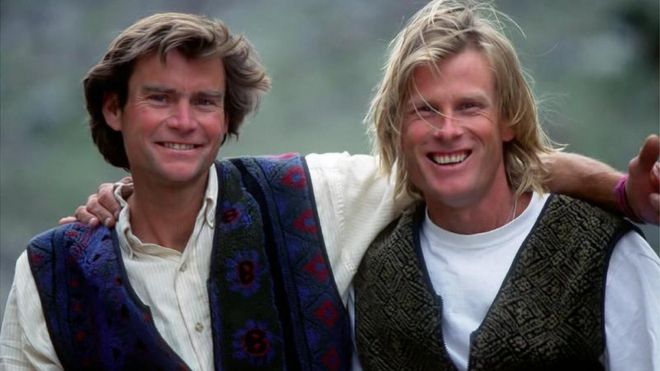BOSTON (Reuters) - The bodies of renowned U.S. mountaineers Alex Lowe and David Bridges, who died in a 1999 avalanche in the Himalayas, have been found by another pair of climbers, according to a charity founded and run by Lowe's widow.
Climbers David Goettler of Germany and Ueli Steck of Switzerland were preparing for an attempt to reach the summit of Shishapangma in Tibet, the world's 14th-highest peak, when they discovered two bodies encased in ice on a glacier, the Alex Lowe Charitable Foundation said on its website on Friday. The bodies had clothing and backpacks that matched the gear Lowe and Bridges were wearing when they disappeared.
NBC News reported the bodies were found last week.
Lowe, who was 40 at the time of his death, was regarded as the best American mountaineer of his generation when he and Bridges were swept away during an expedition that aimed to ski down the 26,291-foot (8,013 m) peak. A third climber, Conrad Anker, was injured but survived.
"Alex and David vanished, were captured and frozen in time," Lowe's widow, Jenni Lowe-Anker, said in a statement. "Now they are found. We are thankful. Conrad, the boys and I will make our pilgrimage to Shishapangma. It is time to put Alex to rest."
Lowe-Anker married Anker in 2001 and the climber adopted her three sons. She serves as president of the Lowe foundation, which provides advice and financial support to humanitarian programs that operate in remote parts of the world.
Lowe's accomplishments included two climbs to the top of Mount Everest, the world's highest peak, several first ascents in Antarctica and dozens of less prominent but highly technical ascents.
Glaciers in the Himalayas have been shrinking in the past few decades, according to a landmark 2013 report by the Intergovernmental Panel on Climate Change. But it is unclear whether the emergence of Lowe's and Bridges' bodies was related to glacial retreat.
"It all depends on the conditions," said Cameron Wake, a glacier expert at the University of New Hampshire's Climate Change Project, who has worked on Shishapangma. "Glaciers are constantly in a state of flux."
Lowe and Bridges are not the first mountaineers whose remains attracted attention when they emerged from ice years after their deaths.
A pioneering 1980 paper in the Journal of Glaciology on the speed of glacial movement hinged on the discovery of equipment from a 1959 expedition led by Briton Keith Warburton to Pakistan's Batura Muztagh mountains, which was likely swept away by an avalanche. Shoes, a hammer and a camera used by the group turned up in 1975 and again later in 1978, leading the paper's author to conclude the glacier in question travelled about 1,300 meters a year.
(Reporting by Scott Malone in Boston; Editing by Bill Trott)


No comments:
Post a Comment